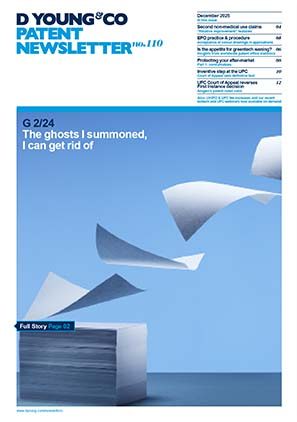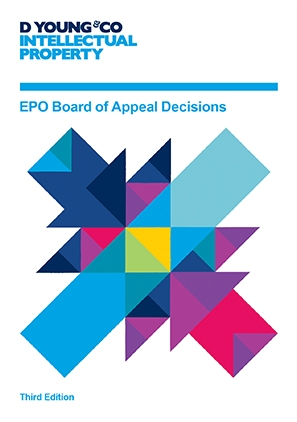T 288/19: assessing inventive step - the business person and the skilled person
In a recent decision by the Board of Appeal, the Board of Appeal considered the relationship between a notional business person and a person skilled in the art when assessing inventive step for “mixed” type inventions (inventions comprising both technical and non-technical features). In this article, we review the decision and consider the potential implications for inventors seeking to protect their inventions in areas such as Fintech (financial technology).
The application
Volcanic activity in Iceland 2010 and the subsequent closure of airspace led to an estimated loss of 1.7 billion US dollars for the airline industry. When aircraft are grounded for more than ten days, airline companies may no longer be able to cover payment of operating resources (such as paying staff salaries, for example). An object of the invention in T 288/19 was to prevent imminent grounding of aircraft fleets due to missing financial resources after risk events and to provide a systematic and automated management of risk exposure.
The solution proposed by the invention relates to automatically paying financial compensation to the affected business units (airlines and their fleets) by monitoring relevant airport data, defining critical thresholds and automating cover payments in the case of airport closures.
The patent application for the claimed invention was refused by the Examining Division on the ground of lack of inventive step (Article 56 EPC). An appeal against the decision to refuse the application was then filed.
Legal background
At the European Patent Office (EPO) an invention is considered as involving an inventive step if, having regard to the state of the art, it is not obvious to a person skilled in the art (Article 56 EPC).
The question as to whether an invention is obvious for the skilled person in the art is often assessed through the established problem-solution approach. However, the assessment becomes more complicated for “mixed” type inventions –those inventions comprising both technical and non-technical features. For mixed type inventions, all those features which contribute to the technical character of the invention are taken into account during the assessment of inventive step. These include the features which, when taken in isolation, are non-technical, but do, in the context of the invention, contribute to the technical character of the invention (see Guidelines for Examination, Part G, Chapter VII, Section 5.4). Features which do not contribute to technical character of the invention cannot support the presence of an inventive step (T 641/00 and G 1/19).
In T 1463/11, the Board of Appeal introduced the concept of the notional business person to help separate the business considerations and the technical considerations for the assessment of inventive step. This ensured that all technical matter in a mixed type invention was able to contribute to an inventive step.
Appellant’s arguments
Following T 1463/11, the appellant argued that the skilled person for the case under appeal was a business person. Therefore, according to the appellant, the question of inventive step should be assessed through the eyes of whether the invention is obvious to the business person.
At oral proceedings, the appellant formulated the technical problem as, “if airports are closed we cover the financial damage: how can we trigger the payouts quickly and automatically”.
The appellant argued that the skilled person (who was a business person in the case under appeal) would not be able to implement the necessary features in order to solve this objective technical problem. In particular, the appellant argued that the business person would not be able to create a robust, effective and reliable software implementation making the link between the spread of closed airports and the automated payment of insurance cover premiums.
Accordingly, the appellant argued that the claimed invention involved an inventive step over the teachings of the cited prior art.
The decision
For mixed type inventions, the Board of Appeal agreed that the notional business person defines the framework conditions for the system. However, in the case under appeal, the Board of Appeal held that the skilled person was not actually the notational business person, but rather a computer specialist. This is because the Board of Appeal concluded that the solution of the problem concerns principally re-programing the central CPU of the closest prior art.
Therefore, the Board of Appeal identified a clear distinction between the business person and the skilled person; the business person provides the framework and object of the invention while the skilled person seeks a solution to this object within the framework provided by the business person.
As an example, the Board of Appeal explained that a business person may instruct an engineer to design a double-decker aircraft for up to 850 passengers with a budget of 10 billion US dollars. The solution to this problem is not, however, found by the business person. Rather, the Board of Appeal explained that the solution can only be provided by a technically skilled person such as an engineer.
The Board of Appeal concluded that the application under appeal involved the automated payment of insurance premiums based on a minimum number of airport closures, according to a geographical spread. Thus, the insurance policies would define this business framework. The skilled person had to provide the technical implementation (the software implementation of the business method) within this business framework.
Accordingly, the Board of Appeal formulated the objective technical problem as that of, “technically implementing an automated management of financial risk exposure of scheduled flights due to airport closures” – this included implementing any non-technical features which had been claimed.
The Board of Appeal held that the business person sets the framework of the problem to be solved by their business model (insurance conditions in the present case) and thus reduces – by setting specific boundary conditions – the degrees of freedom of the skilled person (for example, a computer specialist). The technically skilled person, who has to solve the objective technical problem of implementation, therefore has no latitude in selecting the corresponding (physical) parameters. The Board of Appeal found that working out the specific implementation of the features followed in an obvious and straightforward manner from the teachings of the cited prior art and from the problem to be solved.
For these reasons, the Board of Appeal held that the claimed invention did not involve an inventive step and the appeal was dismissed.
Implications of the decision and application to Fintech
In T 288/19, the Board of Appeal formed a clear distinction between the notional business person and the person skilled in the art. The business person sets the framework for the problem to be solved by their business model and thus, by setting specific boundary conditions, reduces the degrees of freedom of the skilled person. However, it is the technically skilled person who has to solve the objective technical problem of implementation. The skilled person has no latitude in selecting corresponding parameters of this implementation.
When filing an application for an invention in an area of technology which could be considered as a mixed type invention (comprising both technical and non-technical features) it therefore becomes even more important to clearly define the technical solution provided by the invention (even if that technical solution is disclosed in the context of a specific business situation). An applicant will be unlikely to be able to rely on specific requirements of the underlying business model during the assessment of inventive step (as these requirements would be provided to the skilled person as specific boundary conditions of the problem to be solved).
Accordingly, T 288/19 may have specific implications for Fintech inventions, as demonstrated by the following hypothetical example.
Cash can be used to complete financial transactions in a number of different situations. For example, cash can be used by a customer to purchase goods in a shop or other retail environment operated by a merchant. However, when cash is used by a customer to complete a transaction, it is often necessary for the merchant to provide the customer with change, as the customer may not have the exact amount of cash available for the transaction. As such, the merchant must ensure that they have enough money in the cash register to provide change to a customer (and that this money is of an appropriate distribution of denominations).
On other hand, the merchant does not want to have too much cash in the cash register as holding unnecessary amounts of cash can impede liquidity. Moreover, holding a large amount of cash is often undesirable for security.
The system must also be resistant to shocks (for example, if an unexpectedly large number of customers seek to purchase goods with cash). Otherwise, a merchant may not be able to complete a transaction with a customer. Moreover, the problem may be further complicated if a merchant operates multiple cash registers in a single retail environment.
An invention in this field may seek to address a problem of triggering a certain financial response to ensure that each cash register has sufficient cash of each denomination in order to provide a customer with change if they purchase goods with cash.
By analogy to T 288/19, it would appear that obviousness should be assessed through delegation of certain tasks between the business person and the skilled person. The business person would set the framework of the problem to be solved by their business model (for example, liquidity conditions) while the skilled person would be tasked with solving the objective technical problem of implementation of the business model within the framework established by the business person (the technical tasks of constructing a system to monitor the levels of cash in the cash register and programming a computer to implement the liquidity conditions).
Accordingly, inventive step would have to be demonstrated by the specific technical implementation of the business model. This may include any feature which provides a technical solution to a technical problem. For example, the technical contribution of a specific implementation may be demonstrated by a specific adaptation for internal functioning of a computer system or network which enables the model to be operated with improved computational efficiency.
However, following T 288/19, specific conditions or features related to the underlying business model – such as specific financial response packages – would not contribute to the assessment of inventive step as they would likely be provided to the skilled person as part of the framework of the problem to be solved.
Conclusion
In T 288/19, the Board of Appeal defined a clear distinction between the roles of the business person and the skilled person during the assessment of inventive step.
The business person sets the framework of the problem to be solved by their business model, while the technically skilled person (under the direct instruction of the business person) solves the objective technical problem of implementation of the solution to the business problem.
Therefore, the Board of Appeal has confirmed that an applicant will not be able to rely on specific non-technical constraints of the underlying business model during the assessment of inventive step at the EPO.


